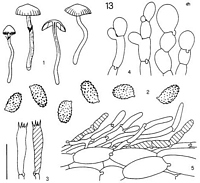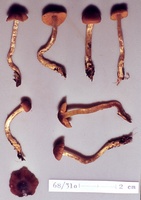|
 Dermocybe indotata Dermocybe indotata
SynonymsCortinarius indotatus
BiostatusPresent in region - Indigenous. Endemic
Images (click to enlarge)
Caption: Dermocybe indotata: 1. carpophores. - 2. spores. - 3. basidia. - 4. cheilocystidia. - 5. pileipellis. | 
Caption: ZT68-310 , Holotype
Owner: E. Horak: © Creative Commons Attribution-Noncommercial 3.0 New Zealand |
Article: Horak, E. (1988) [1987]. New species of Dermocybe (Agaricales) from New Zealand. Sydowia 40: 81-112.
Description: Pileus -25 mm, hemispherical or conico-convex, usually with small umbonate papilla at centre in mature specimens; black, fuscous or yellow-brown (with olive tinge) at centre, paler to pale yellow-brown towards margin; dry, hygrophanous, indistinctly striate near margin, coarsely fibrillose, conspicuous veil remnants absent. - Lamellae 12-20, -3, adnexed to broadly adnate, -3 mm wide; bright mustard yellow or orange-brown, with ferruginous tinge in old material, edges concolorous or paler, fimbriate from cheilocystidia. - Stipe - 5 x -3 mm, cylindrical, sometimes attenuated at base, single or cespitose; yellow, below inconspicuous cortina with fragmentary, yellow or pale rust brown veil zones; dry, fibrillose, hollow. - Context yellow-brown-olive in pileus, brown-black in base of stipe. - Odour and taste raphanoid. - Chemical reactions on pileus: KOH - red brown to brown; HCl, NH3 - negative.
Spore print rust brown. - Spores 6-7(-7.5) x 3.5-4.5 µm, ovoid to elliptical, verrucose, rust brown. - Basidia 20-28 x 5-7 µm, 4-spored, often with red-brown plasmatic pigment. - Cheilocystidia conspicuous, composed of cell-chains, terminal cells (10-30 x -15 µm) clavate to ovoid, membranes thin-walled, with red-brown to wine red plasmatic pigment. - Pileipellis a cutis (or a trichoderm) composed of cylindrical hyphae (5-12 µm diam.), terminal cells cylindrical or conical, membranes not gelatinised, with pale red-brown to grey-lilac plasmatic pigment readily dissolving in KOH. - Clamp connections present.
Habitat: On soil in forests dominated by Nothofagus-Leptospermum. - New Zealand.
Notes: D. indotata shares its most distinctive microscopical character, viz. the remarkably small spores, with D. largofulgens. From the latter species it is distinguished, however, by the dry and much darker pileus, the presence of balloon-shaped cheilocystidia and its occurrence in Nothofagus-forests. As principal pigments emodin and its glucoside have been identified which are absent on chromatograms obtained from D. largofulgens (KELLER & al., 1988).
|